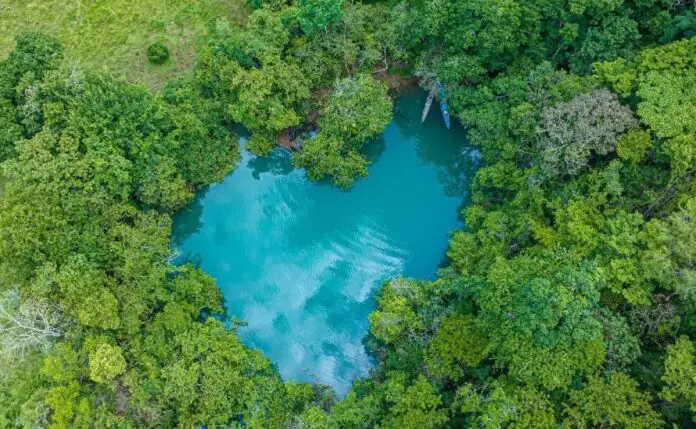Veracruz hides a hidden treasure, an impressive lagoon that stands out for its blue tones and heart shape. Find out where it is and how to get there.
While Tulum and Yucatán are known for their impressive cenotes and surrounding nature, Veracruz holds a treasure that very few know about and that rivals these two destinations.
It is called “El Ojo de la Gringa,” an incredible heart-shaped lagoon with turquoise waters hidden in the nature of southern Veracruz, specifically in the Zoque jungle. This pool, hidden in the locality of José Cardel in the municipality of Minatitlán, is 14 meters deep and 50 meters in diameter. Although its blue waters are surprising, it is mainly visited by extreme sports enthusiasts.
Its name, “El Ojo de la Gringa,” was given because when viewed from the air, it looks like a turquoise blue eye surrounded by trees.
Many visitors often compare this destination to the cenotes of Yucatán and Tulum, as the turquoise colors and crystal-clear water allow the reflection of fish to be seen in this lagoon. According to local media, divers who have submerged to the depths of “El Ojo de la Gringa” in Veracruz revealed that at the bottom, three supposed rings can be seen where the water flows.
How to Get to “El Ojo de la Gringa,” a Lagoon in Southern Veracruz
If you have decided to visit “El Ojo de la Gringa,” here is how you can get to this lagoon in southern Veracruz. First, you must arrive in the city of Minatitlán, where you will have to take the road towards Cerro de Nanchital. At one point, you will find the sign for Ojo de la Gringa, from there you will travel on a dirt road for approximately 10 minutes to the José Cardel ejido dock.
Once at the dock, you will have to take a boat that costs between 120 to 150 pesos per person and takes you along the Uxpanapa River. If you enter to swim, you will have to pay an additional 30 pesos.
It should be noted that this area is pristine and is cared for by the inhabitants of the José Cardel community, so the cost for swimming is allocated to the conservation and cleaning of the lagoon.
Source: Debate






